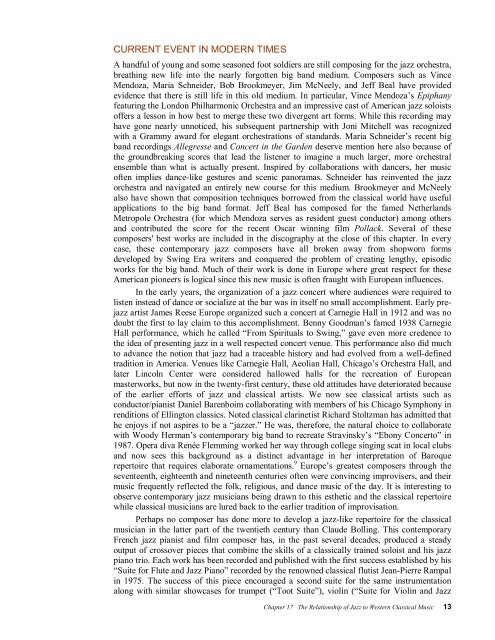THE RELATIONSHIP OF JAZZ TO WESTERN CLASSICAL MUSIC
THE RELATIONSHIP OF JAZZ TO WESTERN CLASSICAL MUSIC
THE RELATIONSHIP OF JAZZ TO WESTERN CLASSICAL MUSIC
You also want an ePaper? Increase the reach of your titles
YUMPU automatically turns print PDFs into web optimized ePapers that Google loves.
CURRENT EVENT IN MODERN TIMES<br />
A handful of young and some seasoned foot soldiers are still composing for the jazz orchestra,<br />
breathing new life into the nearly forgotten big band medium. Composers such as Vince<br />
Mendoza, Maria Schneider, Bob Brookmeyer, Jim McNeely, and Jeff Beal have provided<br />
evidence that there is still life in this old medium. In particular, Vince Mendoza’s Epiphany<br />
featuring the London Philharmonic Orchestra and an impressive cast of American jazz soloists<br />
offers a lesson in how best to merge these two divergent art forms. While this recording may<br />
have gone nearly unnoticed, his subsequent partnership with Joni Mitchell was recognized<br />
with a Grammy award for elegant orchestrations of standards. Maria Schneider’s recent big<br />
band recordings Allegresse and Concert in the Garden deserve mention here also because of<br />
the groundbreaking scores that lead the listener to imagine a much larger, more orchestral<br />
ensemble than what is actually present. Inspired by collaborations with dancers, her music<br />
often implies dancelike gestures and scenic panoramas. Schneider has reinvented the jazz<br />
orchestra and navigated an entirely new course for this medium. Brookmeyer and McNeely<br />
also have shown that composition techniques borrowed from the classical world have useful<br />
applications to the big band format. Jeff Beal has composed for the famed Netherlands<br />
Metropole Orchestra (for which Mendoza serves as resident guest conductor) among others<br />
and contributed the score for the recent Oscar winning film Pollack. Several of these<br />
composers' best works are included in the discography at the close of this chapter. In every<br />
case, these contemporary jazz composers have all broken away from shopworn forms<br />
developed by Swing Era writers and conquered the problem of creating lengthy, episodic<br />
works for the big band. Much of their work is done in Europe where great respect for these<br />
American pioneers is logical since this new music is often fraught with European influences.<br />
In the early years, the organization of a jazz concert where audiences were required to<br />
listen instead of dance or socialize at the bar was in itself no small accomplishment. Early pre<br />
jazz artist James Reese Europe organized such a concert at Carnegie Hall in 1912 and was no<br />
doubt the first to lay claim to this accomplishment. Benny Goodman’s famed 1938 Carnegie<br />
Hall performance, which he called “From Spirituals to Swing,” gave even more credence to<br />
the idea of presenting jazz in a well respected concert venue. This performance also did much<br />
to advance the notion that jazz had a traceable history and had evolved from a welldefined<br />
tradition in America. Venues like Carnegie Hall, Aeolian Hall, Chicago’s Orchestra Hall, and<br />
later Lincoln Center were considered hallowed halls for the recreation of European<br />
masterworks, but now in the twentyfirst century, these old attitudes have deteriorated because<br />
of the earlier efforts of jazz and classical artists. We now see classical artists such as<br />
conductor/pianist Daniel Barenboim collaborating with members of his Chicago Symphony in<br />
renditions of Ellington classics. Noted classical clarinetist Richard Stoltzman has admitted that<br />
he enjoys if not aspires to be a “jazzer.” He was, therefore, the natural choice to collaborate<br />
with Woody Herman’s contemporary big band to recreate Stravinsky’s “Ebony Concerto” in<br />
1987. Opera diva Renée Flemming worked her way through college singing scat in local clubs<br />
and now sees this background as a distinct advantage in her interpretation of Baroque<br />
repertoire that requires elaborate ornamentations. 9 Europe’s greatest composers through the<br />
seventeenth, eighteenth and nineteenth centuries often were convincing improvisers, and their<br />
music frequently reflected the folk, religious, and dance music of the day. It is interesting to<br />
observe contemporary jazz musicians being drawn to this esthetic and the classical repertoire<br />
while classical musicians are lured back to the earlier tradition of improvisation.<br />
Perhaps no composer has done more to develop a jazzlike repertoire for the classical<br />
musician in the latter part of the twentieth century than Claude Bolling. This contemporary<br />
French jazz pianist and film composer has, in the past several decades, produced a steady<br />
output of crossover pieces that combine the skills of a classically trained soloist and his jazz<br />
piano trio. Each work has been recorded and published with the first success established by his<br />
“Suite for Flute and Jazz Piano” recorded by the renowned classical flutist JeanPierre Rampal<br />
in 1975. The success of this piece encouraged a second suite for the same instrumentation<br />
along with similar showcases for trumpet (“Toot Suite”), violin (“Suite for Violin and Jazz<br />
Chapter 17 The Relationship of Jazz to Western Classical Music 13

















